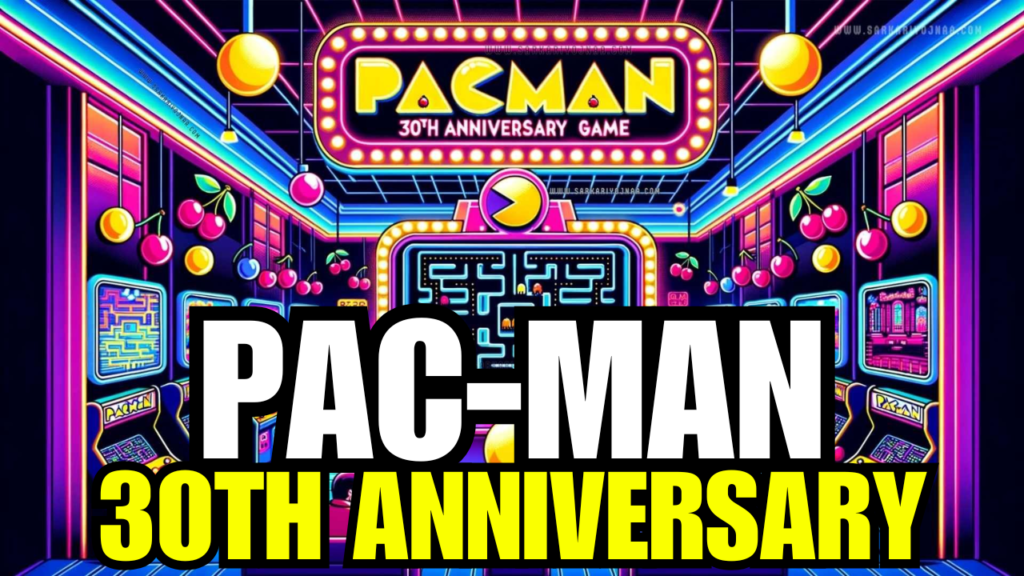
In 2010, video game fans around the world celebrated a monumental milestone—the pacman 30th anniversary, one of the most iconic and enduring video games in history. Released by Namco on May 22, 1980, Pac-Man has become more than just a game; it’s a cultural touchstone that has shaped the entire gaming industry and influenced generations of players. Over the last three decades, this simple yet addictive maze-chase game has remained as relevant as ever, attracting new fans while maintaining a loyal following from its golden age of arcades. As we reflect on the 30th anniversary of Pac-Man, it’s impossible to ignore the incredible impact it has had on both the gaming world and popular culture at large.
In this article, we’ll explore the history of Pac-Man, its groundbreaking design, and how it continues to leave a lasting legacy on gaming today. We’ll also provide an in-depth overview of the game’s mechanics, gameplay, and the unique features that made it a global phenomenon.
The Birth of Pac-Man: A Game That Changed Everything
When Pac-Man was released in 1980, video games were largely dominated by military and space-themed titles like Space Invaders, Asteroids, and Galaga. These games were often about shooting enemies or avoiding projectiles, and they primarily appealed to young male players. Namco’s Toru Iwatani, the designer behind Pac-Man, recognized the need for a game that would attract a wider audience, including women, who were often excluded from the action-packed, competitive genres of the time.
Iwatani’s solution was to create a non-violent, colorful, and easy-to-understand game with a relatable and friendly protagonist. Inspired by a pizza with a slice missing, he designed a round, yellow character that would come to be known as Pac-Man. The name “Pac-Man” itself comes from the Japanese word “paku,” which means “to eat” or “to gulp,” referencing the game’s central mechanic—Pac-Man constantly chomping dots.
Instead of focusing on shooting or fighting, Pac-Man centered around collecting small dots (called pellets) while avoiding enemies. This emphasis on navigating mazes, evading enemies, and collecting items helped set Pac-Man apart from other arcade games. The goal was simple: clear the maze of dots while evading the four colorful ghosts who chase you.
Released in Japan in May 1980, Pac-Man quickly became a hit. Its appeal was universal, with easy-to-understand gameplay that attracted people from all walks of life, including women and families. Within months of its release, Pac-Man became the highest-grossing arcade game of all time, surpassing even Space Invaders. It was the beginning of a gaming phenomenon that would define the 1980s and beyond.
The Phenomenon of Pac-Man: Cultural Impact and Merchandising
Pac-Man was more than just a successful arcade game—it became a global cultural phenomenon. The game’s rise to prominence led to a wide range of merchandise, from lunchboxes to T-shirts to even branded cereal. Pac-Man was one of the first games to be recognized as a full-fledged brand, and it captured the hearts of millions beyond the arcade.
In addition to merchandise, Pac-Man made its way into other forms of media. In 1982, The Pac-Man Show, an animated television series, debuted, bringing the yellow hero and his friends to Saturday morning TV. This helped solidify Pac-Man as one of the most recognizable video game characters of the time. Music also played a role in Pac-Man‘s cultural dominance, with the release of the hit song “Pac-Man Fever” by Buckner & Garcia, which reached the Billboard charts in 1982. The song celebrated the game’s addictive nature and was a fitting anthem for the arcade craze that Pac-Man helped fuel.
Moreover, Pac-Man’s influence extended into the world of art, fashion, and even politics. The image of Pac-Man has appeared on everything from posters to graffiti and in discussions about the economic and cultural significance of the video game boom in the early ’80s.
Pac-Man Game Overview: Classic Gameplay That Endures
While Pac-Man is known for its cultural significance, at its heart, it’s a simple and brilliant game. Below is a detailed overview of the gameplay mechanics, objectives, and unique features that made Pac-Man such a groundbreaking title in the world of video games.
Basic Gameplay Mechanics
In Pac-Man, the player controls a yellow, circular character—Pac-Man—who moves through a maze filled with small dots, called pellets. The objective is to eat all the pellets while avoiding the four colorful ghosts that chase Pac-Man through the maze. The maze is structured with walls that Pac-Man cannot pass through, but the goal is to clear each maze of its pellets before being caught by the ghosts.
The Maze:
The maze itself consists of a series of corridors, dead ends, and intersections. Throughout the maze, there are 240 pellets (also known as “dots”) to be eaten. The maze’s design is simplistic, but the challenge lies in navigating it efficiently while avoiding the pursuing ghosts.
The Power Pellets:
Located at the four corners of the maze are larger, flashing pellets known as “power pellets.” When Pac-Man eats a power pellet, the ghosts turn blue and become vulnerable, allowing Pac-Man to eat them for bonus points. The power pellet effect is temporary, and once it wears off, the ghosts return to their normal state and resume their chase.
The Ghosts:
The game features four ghosts, each with its own behavior pattern and strategy:
- Blinky (Red Ghost): Blinky is the most aggressive ghost, constantly chasing Pac-Man.
- Pinky (Pink Ghost): Pinky attempts to ambush Pac-Man by positioning itself in front of him.
- Inky (Cyan Ghost): Inky’s movements are more erratic and influenced by both Blinky’s and Pac-Man’s position.
- Clyde (Orange Ghost): Clyde behaves unpredictably, sometimes chasing Pac-Man and other times wandering away from him.
Understanding how each ghost behaves is crucial to success in the game. While some players may try to memorize the maze, the true challenge of Pac-Man comes from anticipating and reacting to the ghosts’ movements in real-time.
The Fruit and Bonus Items:
Throughout each level, various fruits and items appear in the center of the maze, providing extra points when eaten. These fruits rotate with each level, including items like cherries, strawberries, and oranges, offering players an additional incentive to explore the maze beyond just eating the dots.
Game Levels and Difficulty
The game doesn’t feature traditional levels in the sense of story progression. Instead, the levels are simply variations of the same maze, but with increasing difficulty. As players progress, the speed of the ghosts increases, making it more difficult to avoid them and clear the maze. Additionally, the ghosts become more strategic in their pursuit, making the game increasingly challenging.
Scoring and High Scores
The primary goal of Pac-Man is to achieve the highest possible score by eating dots, eating ghosts after consuming a power pellet, and collecting fruit. Every pellet eaten adds 10 points, each ghost eaten after a power pellet provides bonus points, and the fruits provide varying point values.
The competitive nature of the game, combined with the desire to achieve a high score, was a key factor in Pac-Man‘s success in arcades. Players would often return to the game to beat their own high scores or to compete with others, further embedding Pac-Man into the fabric of arcade culture.
Game Over and Continual Play
Pac-Man doesn’t have an “end” in the traditional sense. The game continues until the player loses all their lives, which happens when Pac-Man is caught by a ghost. At the beginning of the game, the player has a set number of lives, and after each game is over, the player can insert more coins (or credits) to continue playing. High-level players might even be able to reach the infamous “kill screen”—the 256th level—where the game becomes unplayable due to a technical glitch.
The Enduring Appeal of Pac-Man
What makes Pac-Man endure decades after its release is its simplicity. The concept of guiding a character through a maze while avoiding enemies is universal and remains just as engaging today as it was when it first appeared. While many modern games feature intricate plots and stunning graphics, Pac-Man’s straightforward gameplay continues to capture the imagination of players old and new. The simplicity of Pac-Man also makes it accessible, allowing anyone to pick up and play the game with minimal instruction.
The game’s bright colors, catchy sounds, and fast-paced action make it instantly recognizable. The characters—especially Pac-Man himself and the ghosts—are iconic in their own right, cementing Pac-Man‘s place as one of the most beloved video games of all time.
pacman 30th anniversary: A Celebration of Gaming History
In 2010, pacman 30th anniversary was celebrated with special releases, commemorative merchandise, and events all over the world. The anniversary also saw the release of Pac-Man Championship Edition DX, a modern reimagining of the classic game that introduced new features, such as time-based challenges and more complex maze designs, while maintaining the core gameplay mechanics.
Namco, the developer behind Pac-Man, also released various remakes of the original game on consoles, mobile devices, and even as part of retro arcade collections. These efforts helped bring Pac-Man to a new generation of gamers, ensuring that the yellow hero would remain relevant in an ever-evolving gaming landscape.
The Pacman 30th anniversary serves as a reminder of how far video games have come in the past few decades and how Pac-Man helped lay the foundation for the modern gaming industry. From its humble arcade beginnings to its status as a global cultural icon, Pac-Man has had a lasting influence on game design, player behavior, and the way we think about video games.
Conclusion on pacman 30th anniversary
As Pac-Man celebrates its 30th anniversary, it’s clear that this game is more than just a nostalgic relic of the past. It remains a symbol of the power of video games to bring people together, foster competition, and spark creativity. Whether you’re playing the original arcade version, a modern remake, or simply enjoying its influence on the games of today, Pac-Man’s enduring legacy is a testament to the timeless appeal of this beloved classic.
The game pacman 30th anniversary isn’t just a celebration of Pac-Man itself, but of the entire video game industry and the cultural impact that gaming has had on the world. Pac-Man will forever remain one of the most important and recognizable games in history, and its legacy will continue for generations to come.







